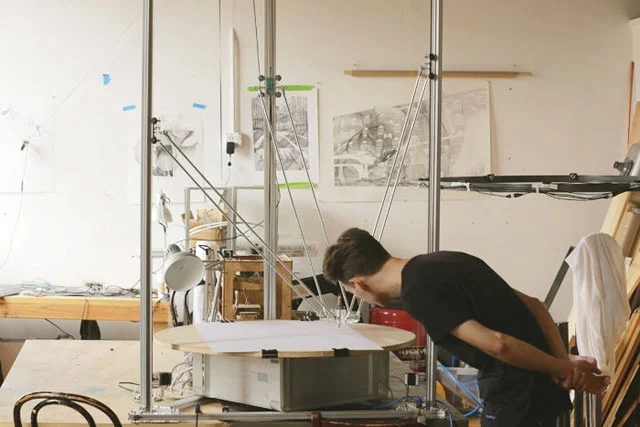Liminal Surface
Liminal Surface, a collaborative piece between Ali Momeni and David Blithell, is a prime example of Momeni's work. Blending innovative performative practices with sophisticated technology, Liminal Surface has a portable, “table-top” design allowing it to function more along the lines of a traditional instrument but with none of the traditional approaches to playing it. The performer interacts with a series of audio, video, analog and digital sensors which control a robotically produced auditory output. The surface is modular, and the output varies depending on the pieces occupying the surface and the performers interaction with those pieces. The human performer acts as a conductor orchestrating the music’s composition with the aid of the robots. Bithell and Momeni dramatize this interaction in their theatrically staged performances. They not only perform the piece musically, they choreograph their movement and interaction with the computer bringing the digitized instrument to life as a third actor in the troupe:
"We essentially made a theatrically presentable large-scale prototyping board. Once a gadget is plugged into the table it’s in instant high-speed two-way communication with real-time software – thus allowing us to theatrically compose for the interactions between us and the objects, as well as among the objects themselves." (Ali Momeni)
The interplay between Moment and Bithell is rehearsed in unison with the computer. The compositional result feels part human, part computer software, and wholly unique.
The conceptual inspiration for the piece comes from Frued’s notions of the uncanny:
“In [The Uncanny], Freud points to the unique power of inanimate objects that portray animate behavior: a sculpted skull that appears to speak, an isolated fabricated eyeball that blinks or a pair of disembodied legs that move about as if led by a human mind.” (Ali Momeni)
Liminal Surface becomes about the uncanny the moment Momeni and Bithell begin to draw noise out of what appears to be light and air. They are presenting the audience with a completely unfamiliar presentation of theatre and musical composition. The interplay between computer, machine, and human vitalizes the inanimate board. The resulting cacophony and frantic movement from human and machine is an alien display in which one is unsure who has complete authority. In one solo performance performed at the Loop Festival in Austin, Texas, Bithell appears dumbfounded by the unanticipated output of the blocks before him. The primitive display on the part of the human emphasizes how computer-based control of external media is a very unfamiliar, or uncanny, concept to most, and the use of the word ‘liminal’ in the title further frames the public discourse as being in its initial stages. The performance artistically sheds light on the emerging relationship between robots and humans utilizing the very media it looks to critique. The bizarre auditory output coupled with the optics of the performance not only creates an uncanny environment for the audience, but it frames the technology being used as a foreign concept. Thus, one may look at the performance of Liminal Surface as a metaphor for the public discourse regarding physical computing. The interaction between human and object stresses the hand humans have in developing robotic technologies, but the simplicity of the performers interactions with the sensory interface suggest an ignorance of their practicality as tools or instruments. The performance becomes a dramatic exploration of these emerging dialogues at the intersection of art, design, and technology.
Framing the performance as a primitive interaction between human and computers receives its conceptual basis in the partners earlier work, Table Setting. This piece is an early example of the table top format, small sculptural agents that act as both instruments and actors in a choreographed, musical, theatrical performance. Both Liminal Surface and Table Setting utilize wooden blocks, small cymbals, and metal rods, as the inanimate actors for the performance, however the digital components used in Table Setting are far less sophisticated. Liminal Surface pushes the variety and complexity of ways to interact with these very basic sculptural elements. While the overall tone of the interaction is in playful conversation with music and physical computing, the increased computational sophistication in Liminal Surface deepens the conceptual conversation to include how our relationship with these technologies is evolving.
One would be hard pressed to fit the artistic contributions of Liminal Surface into any one genre. While it is presented as a musical theatrical performance, the computing and machinery puts it in the same realm as robotic artists such as Chico Macmurtie and Amorphic Robot Works. These artists are pushing the artistic capabilities of robots, and their musical performance work on its surface is the more advanced, autonomous version of Momeni and Bithell’s musical robots. The performers in The Robotic Church are a collection of anthropomorphized heaps of metal brought to life through computer software. Each robot musician represents an advancement in the capability of a robot to perform musically, suggesting a similar general idea to those expressed in Liminal Surface on the evolution of physical computing and our relations with robots. There is a stark contrast however in that their is a removed human presence, the robots are more sophisticated, and the musical output is timed and run solely by computer. This separates the The Robotic Church conceptually as it lacks the implication of the human role in the evolutionary process, and the timed score of the performance further differentiates the piece conceptually as the robots begin to feel more sculptural and sterile. Despite the differences, both of these pieces do accomplish the uncanny feat of transforming wood, metal, and other junk into a musician.
Links -
http://alimomeni.net/
http://www.davidbithell.com/
http://wiki.imal.org/contributor/ali-momeni
https://cycling74.com/2010/05/25/an-interview-with-ali-momeni/#.V0cdSJMrKAw
Liminal Surface - http://alimomeni.net/project/liminal-surface
Table Setting - http://alimomeni.net/project/table-setting-vooruit/
Chico Macmurtie and Amorphic Robot Works' website - http://amorphicrobotworks.org/works/theroboticchurch/index.htm






